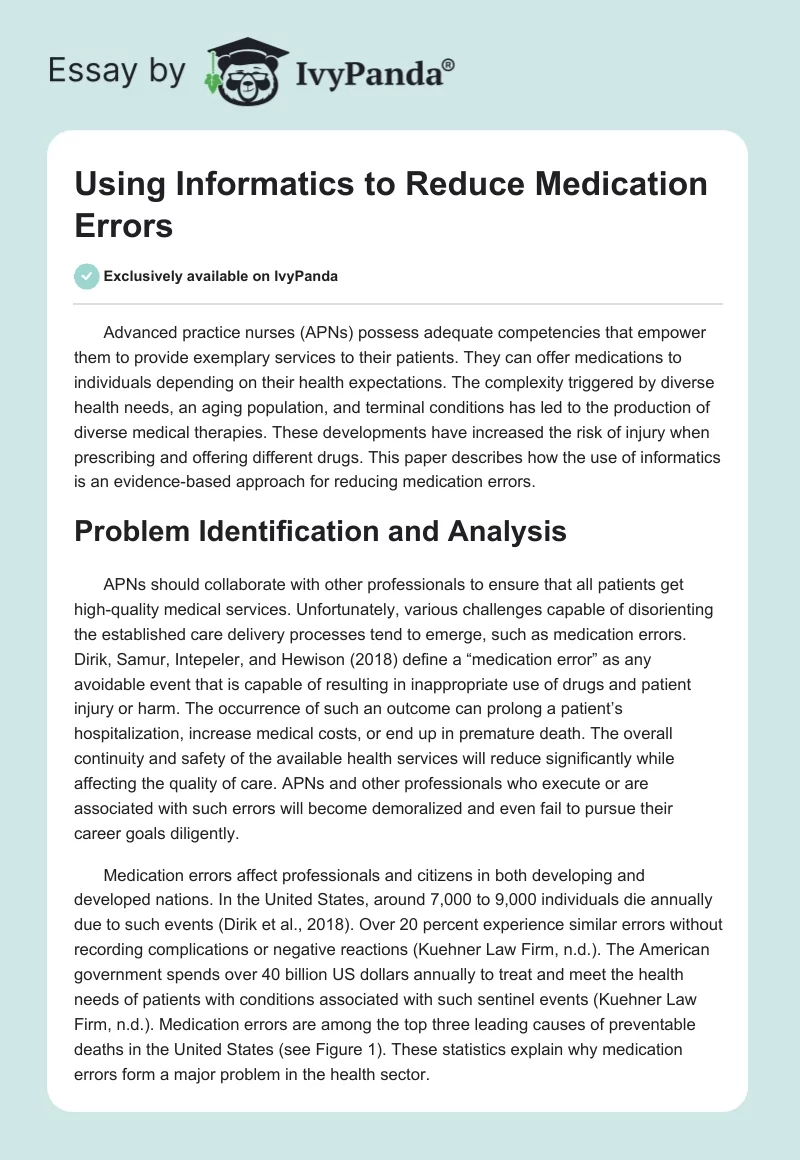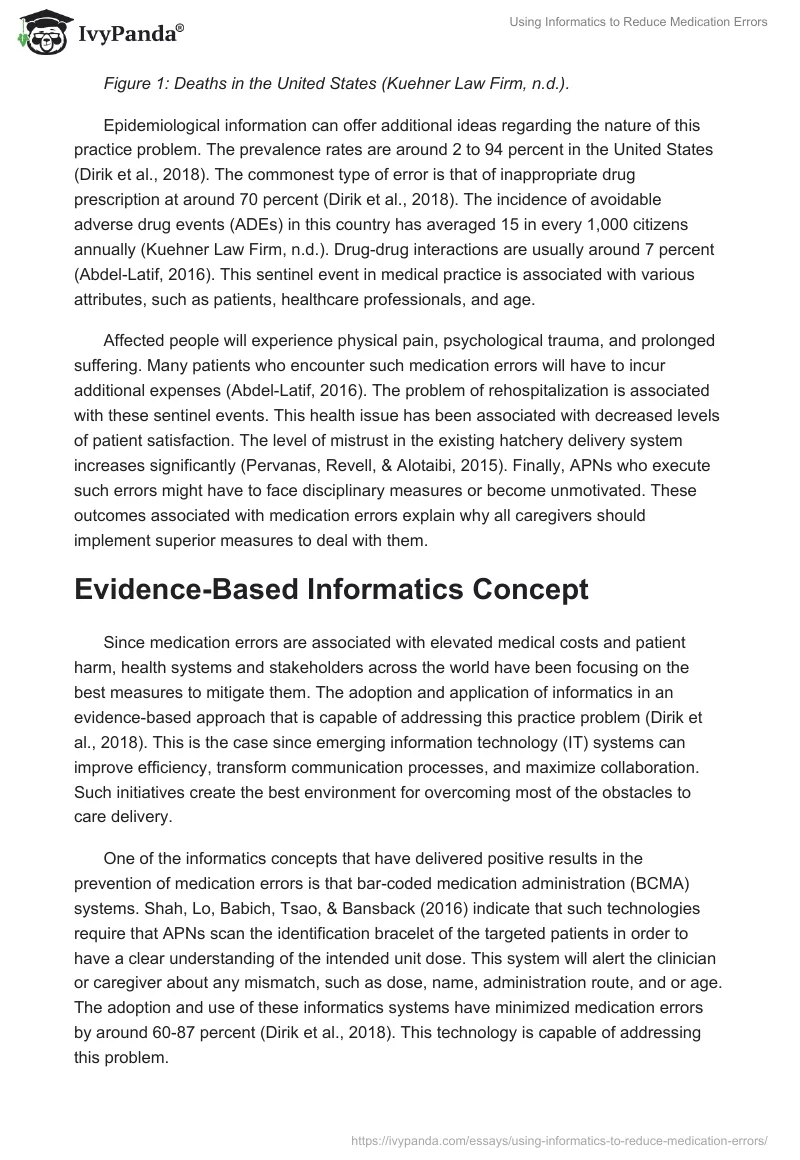Advanced practice nurses (APNs) possess adequate competencies that empower them to provide exemplary services to their patients. They can offer medications to individuals depending on their health expectations. The complexity triggered by diverse health needs, an aging population, and terminal conditions has led to the production of diverse medical therapies. These developments have increased the risk of injury when prescribing and offering different drugs. This paper describes how the use of informatics is an evidence-based approach for reducing medication errors.
Problem Identification and Analysis
APNs should collaborate with other professionals to ensure that all patients get high-quality medical services. Unfortunately, various challenges capable of disorienting the established care delivery processes tend to emerge, such as medication errors. Dirik, Samur, Intepeler, and Hewison (2018) define a “medication error” as any avoidable event that is capable of resulting in inappropriate use of drugs and patient injury or harm. The occurrence of such an outcome can prolong a patient’s hospitalization, increase medical costs, or end up in premature death. The overall continuity and safety of the available health services will reduce significantly while affecting the quality of care. APNs and other professionals who execute or are associated with such errors will become demoralized and even fail to pursue their career goals diligently.
Medication errors affect professionals and citizens in both developing and developed nations. In the United States, around 7,000 to 9,000 individuals die annually due to such events (Dirik et al., 2018). Over 20 percent experience similar errors without recording complications or negative reactions (Kuehner Law Firm, n.d.). The American government spends over 40 billion US dollars annually to treat and meet the health needs of patients with conditions associated with such sentinel events (Kuehner Law Firm, n.d.). Medication errors are among the top three leading causes of preventable deaths in the United States (see Figure 1). These statistics explain why medication errors form a major problem in the health sector.
Figure 1: Deaths in the United States (Kuehner Law Firm, n.d.).
Epidemiological information can offer additional ideas regarding the nature of this practice problem. The prevalence rates are around 2 to 94 percent in the United States (Dirik et al., 2018). The commonest type of error is that of inappropriate drug prescription at around 70 percent (Dirik et al., 2018). The incidence of avoidable adverse drug events (ADEs) in this country has averaged 15 in every 1,000 citizens annually (Kuehner Law Firm, n.d.). Drug-drug interactions are usually around 7 percent (Abdel-Latif, 2016). This sentinel event in medical practice is associated with various attributes, such as patients, healthcare professionals, and age.
Affected people will experience physical pain, psychological trauma, and prolonged suffering. Many patients who encounter such medication errors will have to incur additional expenses (Abdel-Latif, 2016). The problem of rehospitalization is associated with these sentinel events. This health issue has been associated with decreased levels of patient satisfaction. The level of mistrust in the existing hatchery delivery system increases significantly (Pervanas, Revell, & Alotaibi, 2015). Finally, APNs who execute such errors might have to face disciplinary measures or become unmotivated. These outcomes associated with medication errors explain why all caregivers should implement superior measures to deal with them.
Evidence-Based Informatics Concept
Since medication errors are associated with elevated medical costs and patient harm, health systems and stakeholders across the world have been focusing on the best measures to mitigate them. The adoption and application of informatics in an evidence-based approach that is capable of addressing this practice problem (Dirik et al., 2018). This is the case since emerging information technology (IT) systems can improve efficiency, transform communication processes, and maximize collaboration. Such initiatives create the best environment for overcoming most of the obstacles to care delivery.
One of the informatics concepts that have delivered positive results in the prevention of medication errors is that bar-coded medication administration (BCMA) systems. Shah, Lo, Babich, Tsao, & Bansback (2016) indicate that such technologies require that APNs scan the identification bracelet of the targeted patients in order to have a clear understanding of the intended unit dose. This system will alert the clinician or caregiver about any mismatch, such as dose, name, administration route, and or age. The adoption and use of these informatics systems have minimized medication errors by around 60-87 percent (Dirik et al., 2018). This technology is capable of addressing this problem.
The implementation of these informatics systems in the provision of drugs has been observed to reduce most of the mistakes that might emerge. For instance, BMCA systems make it possible for providers to follow all the critical steps or procedures required for successful drug delivery. This is true since practitioners who have access to such technology will verify the required dose and provide drugs at the right time. It will also ensure that drugs are available to the appropriate patients (Kuehner Law Firm, n.d.). The application and use of such systems will make it possible for APNs to check each of these areas for exactness.
The issue of time emerges when health institutions and professionals support the use of BMCA systems. Shah et al. (2016) revealed that paperwork could increase the chances of errors and fatigue. Handwritten elements reduce when practitioners embrace the use of technologies. This means that the possibility of a medication error will decrease since APNs will monitor on-screen alerts and identify any missed steps. With the use of modern informatics, nurses and clinicians can minimize their chances of forgetting patients who require specific drugs. The level of burnout will reduce since such systems are capable of streamlining operations (Shah et al., 2016). With the implementation of similar informatics, healthcare facilities and institutions can minimize medication errors and improve patient satisfaction.
Implementation and Improvement of Outcomes
The suggested system has delivered positive results in many medical institutions across the United States. This is the case since hospitals that use modern informatics will lessen the occurrence of medication errors by around 50 and 80 percent (Pervanas et al., 2015). Since the current application of BMCA lacks clear guidelines, there is a need for an evidence-based implementation strategy to make sure that this technology benefits both patients and providers. Such a procedure can be realized through the utilization of an effective change model. Kurt Lewin’s theory of freezing, changing, and refreezing can deliver positive outcomes (Kuehner Law Firm, n.d.). The first stage will encourage hospitals, patients, and providers to embrace this technology and learn more about its benefits. The next step will ensure that all facilities introduce it in their inpatient and outpatient settings. The final one will make the technology a common practice or procedure for mitigating medication errors.
The most important objective should be to improve the measures and strategies put in place to reduce sentinel events continuously. After introducing the use of BMCA systems, stakeholders can identify new ways of improving performance and ensuring that desirable outcomes are recorded. The first one is identifying emerging technologies that support or expand the applicability of this informatics technology (Dirik et al., 2018). For example, patients and clinicians can be equipped with advanced applications that can read different drugs and alert them effectively. Health institutions can go further to employ BCMA coordinators to ensure that all stakeholders and participants use such technologies efficiently, thereby minimizing the possibility of medication errors.
The current gap in health technological theory and practice can affect the way different APNs adopt or utilize new informatics systems. This challenge can guide health institutions to train all professionals in order to apply the introduced BMCAs systems appropriately (Shah et al., 2016). Medical facilities should develop new teams for focusing on the unintended consequences of technologies, upgrade existing platforms frequently, and identify emerging improvements that can make the informatics system more effective. Information can be collected to monitor the applicability and effectiveness of the BMCA systems (Pervanas et al., 2015). Such measures will eventually result in superior systems that overcome the burden of this practice problem and meet the health needs of more people.
Conclusion
The above discussion has identified medication errors as critical challenges that make it impossible for many patients and APNs to achieve their goals. The use of modern informatics is an evidence-based approach that can empower practitioners and patients to overcome this problem. Health institutions can go further to design superior measures and initiatives that will improve the nature and effectiveness of BMCA systems and eventually transform their patients’ health experiences.
References
Abdel-Latif, M. M. (2016). Knowledge of healthcare professionals about medication errors in hospitals. Journal of Basic and Clinical Pharmacy, 7, 87-92. Web.
Dirik, H. F., Samur, M., Intepeler, S. S., & Hewison, A. (2018). Nurses’ identification and reporting of medication errors. Journal of Clinical Nursing, 28(5-6), 931-938. Web.
Kuehner Law Firm. (n.d.). What is a medical error? Web.
Pervanas, H. C., Revell, N., & Alotaibi, A. F. (2015). Evaluation of medication errors in community pharmacy settings: A retrospective report. Journal of Pharmacy Technology, 32(2), 71-74. Web.
Shah, K., Lo, C., Babich, M., Tsao, N. W., & Bansback, N. J. (2016). Bar code medication administration technology: A systematic review of the impact on patient safety when used with computerized prescriber order entry and automated dispensing devices. The Canadian Journal of Hospital Pharmacy, 69(5), 394-402.


